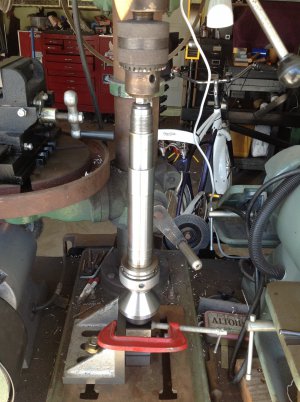Ok.. so I bought a beat-up, thrashed, old Jet BD920n for a couple hundred bucks. Over the last 6 months, I've been taking it apart, cleaning it out, and making some bits to make it somewhat usable. I'm at the point where I need to start aligning and getting it calibrated and I'm kind of at a loss as to where to start and how.
What I have done so far(besides disassembling, cleaning, and lubricating everything):
Made some rough temporary knobs and holders for the controls.. I think the lathe fell on its face and broke a lot of stuff like the cross slide knob, the carriage handwheel, and the shifter lever.
Pulled the spindle and replaced both of the bearings. (I -may- have to do this again, I'm starting to suspect that my method of putting the new bearing races on may have damaged them)
Pulled the compound/cross slide apart, cleaned and replaced the gib screws.
Bought a 4 post compound clamp from littlemachineshop.com to replace the 2 bolt original one.
Installed a quick change tool post from littlemachineshop.com.
Installed a brand new 3-jaw chuck from littlemachineshop.com.
Replaced a ton of fasteners that were stripped out.
The current problems:
1a) The chuck/adapter/spindle assembly has a kink in it somewhere, which causes the part to wobble. By wobble, I mean that if I get a bar held in the chuck, I can get the end next to the chuck to under 2 thou runout, but the other end (12" bar- not a test bar, though) will have 15+thou indicated.. it's visibly moving. I verified that it's not the bar, because I can loosen the chuck and rotate the bar and still have the same high/low spots in relation to the chuck.
1b) The chuck doesn't fit snugly against the spindle adapter reference. With the bolts barely finger tight, I can slide the chuck across the adapter face 2-3 thou.
2) The headstock is definitely not aligned to the ways. Trying to face-off a large part will repeatedly have the tool digging (taking a deeper and deeper cut) in more as it moves towards the back of the lathe.
3) I need to level the ways, but don't have a precision level yet.. the cheapest ones are $100+ that I have seen.
So.. in your opinion, what should be the order of operations here? I am on a limited budged (typically around $150-250/mo, sometimes more). I work at a paper mill, so I can get all kinds of scrap (mostly different types of steel.. sometimes aluminum, very rarely copper or brass) for practicing and making parts. Where am I going to get the most bang for my buck?
What I have done so far(besides disassembling, cleaning, and lubricating everything):
Made some rough temporary knobs and holders for the controls.. I think the lathe fell on its face and broke a lot of stuff like the cross slide knob, the carriage handwheel, and the shifter lever.
Pulled the spindle and replaced both of the bearings. (I -may- have to do this again, I'm starting to suspect that my method of putting the new bearing races on may have damaged them)
Pulled the compound/cross slide apart, cleaned and replaced the gib screws.
Bought a 4 post compound clamp from littlemachineshop.com to replace the 2 bolt original one.
Installed a quick change tool post from littlemachineshop.com.
Installed a brand new 3-jaw chuck from littlemachineshop.com.
Replaced a ton of fasteners that were stripped out.
The current problems:
1a) The chuck/adapter/spindle assembly has a kink in it somewhere, which causes the part to wobble. By wobble, I mean that if I get a bar held in the chuck, I can get the end next to the chuck to under 2 thou runout, but the other end (12" bar- not a test bar, though) will have 15+thou indicated.. it's visibly moving. I verified that it's not the bar, because I can loosen the chuck and rotate the bar and still have the same high/low spots in relation to the chuck.
1b) The chuck doesn't fit snugly against the spindle adapter reference. With the bolts barely finger tight, I can slide the chuck across the adapter face 2-3 thou.
2) The headstock is definitely not aligned to the ways. Trying to face-off a large part will repeatedly have the tool digging (taking a deeper and deeper cut) in more as it moves towards the back of the lathe.
3) I need to level the ways, but don't have a precision level yet.. the cheapest ones are $100+ that I have seen.
So.. in your opinion, what should be the order of operations here? I am on a limited budged (typically around $150-250/mo, sometimes more). I work at a paper mill, so I can get all kinds of scrap (mostly different types of steel.. sometimes aluminum, very rarely copper or brass) for practicing and making parts. Where am I going to get the most bang for my buck?


